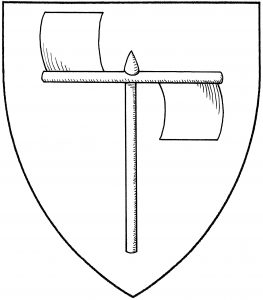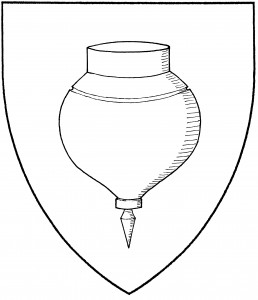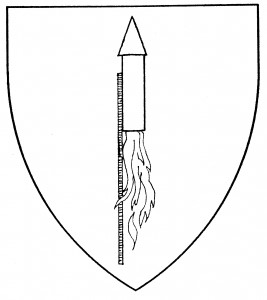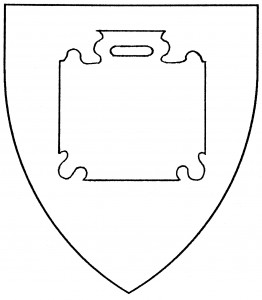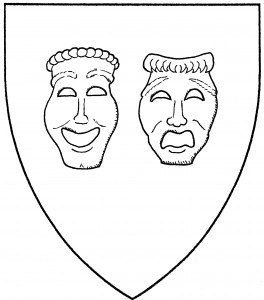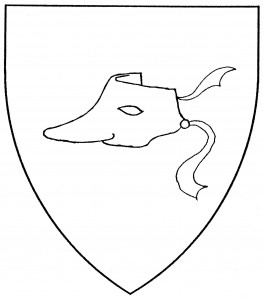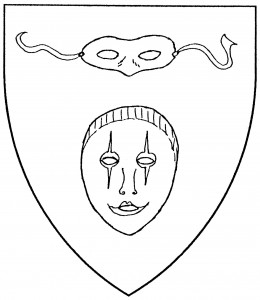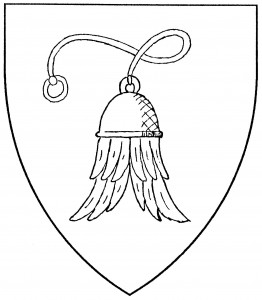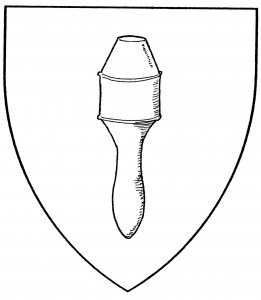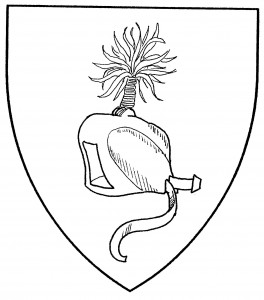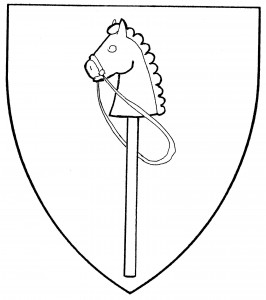The Order of the Whirligig, of the Barony of Delftwood, bears: Azure, a whirligig argent.
Archives
Top, toy
A toy top is, as the name implies, a children’s toy, consisting of a truncated cone which is set to spin on its point. It’s a period charge, found in the canting arms of Topclyff, 1391 [DBA2 401]. The illustration is taken from a Brueghel painting, “Young folk at play”, c.1560. The toy top has its point to base by default.
Máire of Skye bears: Vert, a toy top Or charged with a bar embowed to base purpure.
Joan Silvertoppe bears as a badge: A toy top argent.
Tennis racquet
A tennis racquet, or racket, is used in the game of tennis to swat the ball across the court. It consists of a round frame on a short handle, with a mesh stretched across the frame. It is a period artifact: the illustration is based on an example from 1583 [Gianni Clerici, The Ultimate Tennis Book: 500 years of the sport, fig.11]. Unremarkably, the tennis racquet doesn’t seem to have been used in period armory. The handle is to base by Society default.
Bertrand du Beaumanoir bears: Vert, two tennis rackets in saltire, a bordure embattled Or.
Rocket
A rocket is a long cylinder with a conical point at one end, belching flame at the other; it is used as a projectile, and is more fully termed a “skyrocket”. The Chinese used them as fireworks and signals – the preparation of rockets was described by Marcus Graecus, Book of Fires for the Burning of Enemies, c.1300 [Singer 379] – but rockets were not found in period heraldry. The skyrocket has its point to chief by Society default. For related charges, see pole-cannon.
Thomas MacAndrew bears: Counter-ermine, a skyrocket bendwise Or.
Luke of Bright Hills bears: Or, on a pale between two crescents azure, a rocket Or.
Palette, artist’s
An artist’s palette is a mixing surface for pigment and other media. As an heraldic charge, it is unique to the Society, and is rendered as a conventionalized drawing of a roughly rectangular board with a thumb-hole in it.
David de Kunstenaar bears: Vert, on an artist’s palette Or a lion’s head erased to sinister vert.
Godwig Eadfrithing bears: Argent, on an artist’s palette azure an inkpot argent.
Mask
A mask is an item of clothing that covers the face, usually to hide the wearer’s identity. Though period artifacts, masks don’t seem to have been known to period armory.
In Society armory, common forms of mask include the “masks of comedy and tragedy” or “Thespian masks”, from ancient Greek theatre; the “domino mask” from the Italian Renaissance; and the “half-face mask” or “commedia dell’arte mask”, worn by commedia players in the late 16th Century.
The Society also has examples of the full-face “Pierrot mask”. However, the character of Pierrot didn’t exist until the late 17th Century, and no examples of his mask have been found from before the 19th Century. The Pierrot mask is thus no longer registerable as a charge.
Masks in general are guardant by Society default; the exception is the commedia dell’arte mask, which is shown in profile by default, the better to show its grotesque features.
For related charges, see eyeglasses, head (human’s), hood.
Marc Phillippe bears: Or chapé gules, a domino mask pean.
Hal of the Mask bears: Sable, a tragic mask Or, featured sable.
Gino di Palcoscenico bears: Or, a commedia dell’arte mask in profile reversed sable, hatted and plumed gules.
Edwyn the Player bears: Per pale gules and azure, a partisan spear Or, overall a Pierrot mask argent, orbed and capped sable, with lips gules.
Laurentina of Atenveldt bears: Per bend sinister wavy azure and argent, a mask of comedy and a mask of tragedy within a bordure invected all counterchanged.
Lure
A lure is a pair of bird’s wings tied together at the end of a cord; it’s swung on the cord, mimicking a flying bird, to recall a falcon in flight. It is more fully called a “hawk’s lure” for that reason. It’s a period charge, found in the allusive arms of Fauconer, 1385 [DBA2 386]. The lure’s cord is to chief by default.
A lure is not the same charge as a “vol”, “wings conjoined” or “wings conjoined in lure”, though they are similar.
The Royal University of Scirhavoc bears: Or, on a pale purpure three hawk’s lures Or.
Katerine del Val bears: Vert, in bend three hawk’s lures argent.
William Wildblood bears: Vert, a hawk’s lure argent, a bordure Or.
Juggler’s clubs
Juggler’s clubs are throwing weights with handles, used by jugglers in their profession for their balance. They don’t appear to have been used by jugglers before the 20th Century; no period examples have yet been found. The charge is currently disallowed, pending period evidence. See also staff.
Thomas the Wanderer bears: Argent, a winged sword, wings inverted sable, maintained by a gauntlet issuant from sinister base, in chief two juggler’s clubs in chevron inverted gules.
Hood, hawk’s
A hawk’s hood is a covering for the head of a hawk or falcon, used as a blindfold to keep the bird tranquil. It has no eyeholes, and is usually more decorative than a normal human hood.
Though a period artifact, the hawk’s hood was evidently not an independent charge in period armory. Period heraldic examples show it worn by a hawk, as in the crest of von Waldecker, c.1450 [Ingeram 191]. It doesn’t seem to have a default orientation; the illustration shows a hawk’s hood facing to dexter.
Arik Alton bears as a badge: A hawk’s hood affronty argent.
Hobbyhorse
A hobbyhorse is a figure made of wicker or light wood, meant to resemble a horse. Two types were known in period: a large horse-costume used in medieval festivals in England, and a “stick hobbyhorse” used as a child’s toy (as illustrated in “Young folk at play” by Pieter Brueghel the Elder, c.1560). The latter has been accepted as an heraldic charge in the Society.
The stick hobbyhorse is always so blazoned; it is palewise by Society default. The hobbyhorse’s “proper” tincture is brown, the color of wood. See also staff.
Eduard das Kind bears: Argent, a pair of wooden stick hobbyhorses in saltire proper.
Juliana de Ravenshagh bears: Per chevron inverted vert and argent, an angel argent and two stick hobbyhorses in saltire sable.
